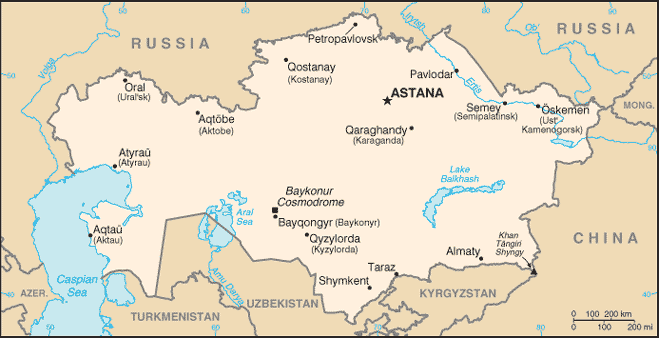|
Home
Word
of the Day
Archives
Clever
Clue of the Month
The
Cruciverbalist
Links
Daily
Email
|
|
ARAL
(AHR-uhl)
An
inland sea of Central Asia
Common
clues:
Shrinking
Asian body of water; Uzbekistan's ___ Sea; Dying sea of Asia; Sea
east of the Caspian; Asia's ___ Sea; Disappearing sea
Crossword
puzzle frequency:
9 times a year
Frequency
in English language:
61345 / 86800
Video: Drying
of the Aral Sea: Timelapse
Animation:
The
shrinking Aral Sea – 1960 till now
The
Aral
Sea is an endorheic inland sea in Central Asia; it lies between
Kazakhstan in the north and Karakalpakstan, an autonomous region
of Uzbekistan, in the south.
Since the 1960s, the Aral Sea has been shrinking, as the rivers
that feed it were diverted by the USSR for irrigation. The Aral
Sea is badly polluted, largely as the result of weapons testing,
industrial projects, and fertilizer runoff before the breakup of
the Soviet Union.

Map
of Kazakhstan (CIA
Factbook)
The
major ecological problem is that diversion of the Amu Darya and
Syr Darya rivers for irrigation has shrunk the Aral Sea
dramatically; the Aral Sea has been drying up for about 40 years.
This has brought about a number of ecological problems both for
the sea and for the surrounding area.

Used
with permission: Rainer
Ressl, Deutschen
Zentrum für Luft- und Raumfahrt
The
Soviet Union decided in 1918 that the two rivers that fed the
Aral Sea—the Amu Darya in the south and the Syr Darya in
the northeast—would be diverted for irrigating the desert
in order to grow rice, melons, cereal, and, above all, cotton;
this was part of the Soviet plan for cotton, or "white
gold," to become a major export. (This did eventually end up
becoming the case, and even today Uzbekistan is one of the
world's biggest exporters of cotton.)
The
sea's surface area has now shrunk by approximately 60 percent,
and its volume by almost 80 percent. Over the same time period,
the salinity of the Aral Sea has increased from about 10 g/l to
about 45 g/l.
The
ecosystem of the Aral Sea and the river deltas feeding into it
has been nearly destroyed, not least because of the much higher
salinity. The land around the Aral Sea is also heavily polluted,
and the people living in the area are suffering from a lack of
fresh water, as well as from a number of other health
problems—the receding sea has left huge plains covered with
salt and toxic chemicals, which are picked up, carried away by
the wind as toxic dust, and spread to the surrounding area; the
population around the Aral Sea now shows high rates of certain
forms of cancer and lung diseases, as well as other diseases.
Crops in the region are also destroyed by salt being deposited
onto the land. The town of Moynaq in Uzbekistan had at one point
a thriving harbor and fishing industry employing approximately
60,000 people; now the town lies miles from the shore. Fishing
boats lie scattered on dry land that was once covered by water;
many of them have been there for 20 years.
Work
is being done to restore in part the North Aral Sea. Irrigation
works on the Syr Darya have been repaired and improved to
increase its water flow, and in October 2003, the Kazakh
government announced a plan to build a concrete dam (Dike
Kokaral) separating the two halves of the Aral Sea. Work on this
dam was completed in August 2005; since then the water level of
the North Aral has risen, and its salinity has decreased. As of
2006, some recovery of sea level has been recorded, sooner than
expected. "The dam has caused the small Aral's sea level to
rise swiftly to 38 m (125 feet), from a low of less than 30 m (98
feet), with 42 m (138 feet) considered
the level of viability." Economically significant stocks of
fish have returned, and observers who had written off the North
Aral Sea as an environmental catastrophe were surprised by
unexpected reports that in 2006 its returning waters were already
partly reviving the fishing industry and producing catches for
export as far as Ukraine. The restoration reportedly gave rise to
long absent rain clouds and possible microclimate changes,
bringing tentative hope to an agricultural sector swallowed by a
regional dustbowl, and some expansion of the shrunken sea. "The
sea, which had receded almost 100 km south of the port-city of
Aralsk, is now a mere 25 km away." There are plans to build
a new canal to reconnect Aralsk with the sea. Construction is
scheduled to begin in 2009, by which time it is hoped the
distance to be covered will be only 6 km. A new dam is to be
built based on a World Bank loan to Kazakhstan, with the start of
construction also slated for 2009.
This
article is licensed under the GNU Free Documentation License
(http://www.gnu.org/copyleft/fdl.html).
It uses material from the http://en.wikipedia.org/wiki/Aral_Sea.
|
|

|